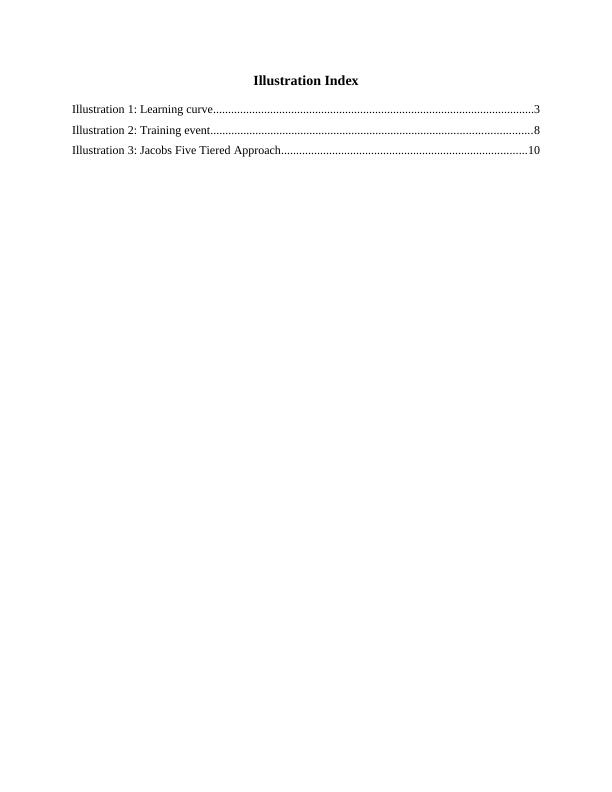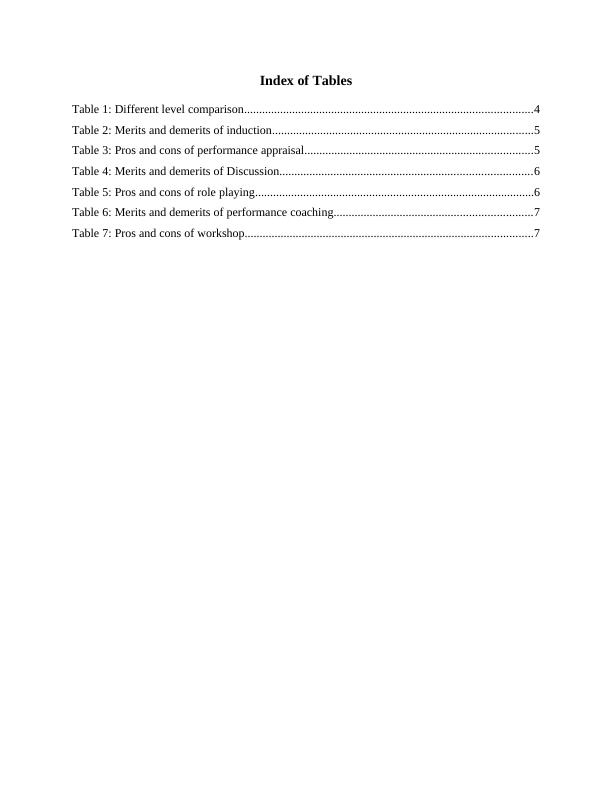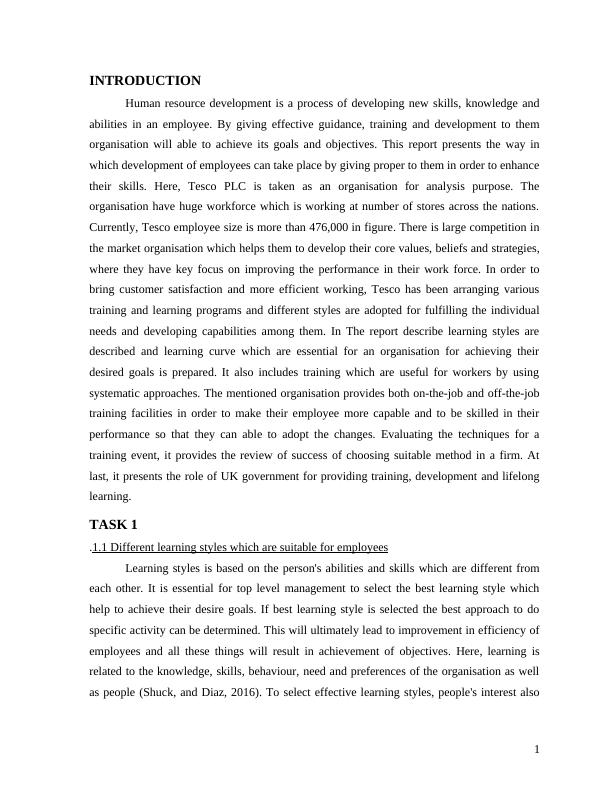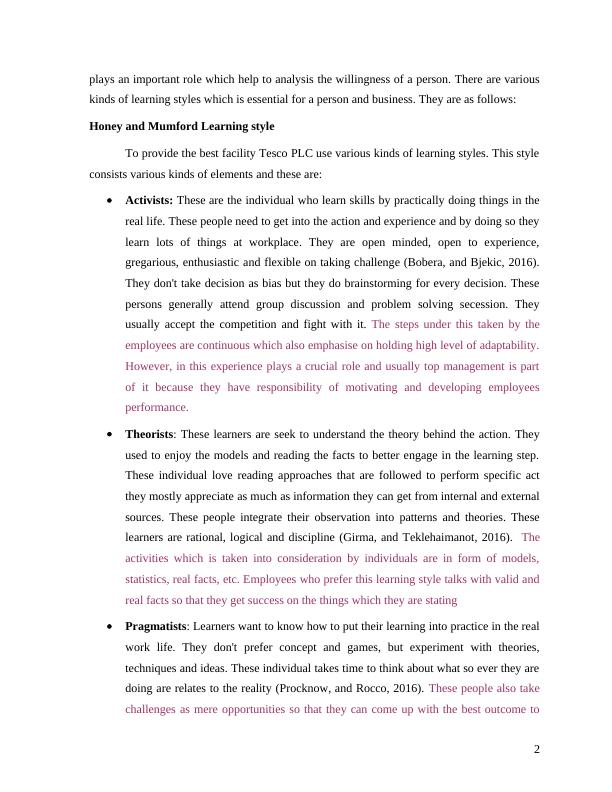Learning curves and theories for staff training methods in Tesco PLC
29 Pages8759 Words222 Views
Added on 2020-06-05
About This Document
Human Resource Development INTRODUCTION 1 TASK 11 .1.1 Different learning styles which are suitable for employees 1 .1.2 Role of learning curve and its importance for transferring learning at workplace2 .1.3 Contribution of learning styles and theories when planning and designing at certain event3 TASK 24 .2.1 Comparison of training needs for staff at different levels in Tesco PLC4 .2.2 Advantages and disadvantage of training methods used in the Tesco PLC. 5 .2.3 Systematic approach to plan training and
Learning curves and theories for staff training methods in Tesco PLC
Added on 2020-06-05
ShareRelated Documents
Human Resource
Development
Development

Table of Contents
INTRODUCTION...........................................................................................................................1
TASK 1............................................................................................................................................1
.1.1 Different learning styles which are suitable for employees.................................................1
.1.2 Role of learning curve and its importance for transferring learning at workplace..............2
.1.3 Contribution of learning styles and theories when planning and designing at certain event
.....................................................................................................................................................3
TASK 2............................................................................................................................................4
.2.1 Comparison of training needs for staff at different levels in Tesco PLC.............................4
.2.2 Advantages and disadvantage of training methods used in the Tesco PLC.........................5
.2.3 Systematic approach to plan training and development for a training event.......................7
TASK 3............................................................................................................................................9
.3.1 Evaluating the suitable techniques.......................................................................................9
.3.2 Carry out an evaluation of a training event........................................................................11
.3.3 Review on evaluation method used in an organisation......................................................12
TASK 4..........................................................................................................................................12
.4.1 Role of government in training, development and lifelong learning ................................12
.4.2 Competency movement impacting both public and private sector....................................13
.4.3 Assessment of contemporary training initiatives introduced by UK government.............13
CONCLUSION..............................................................................................................................14
REFERENCES..............................................................................................................................15
INTRODUCTION...........................................................................................................................1
TASK 1............................................................................................................................................1
.1.1 Different learning styles which are suitable for employees.................................................1
.1.2 Role of learning curve and its importance for transferring learning at workplace..............2
.1.3 Contribution of learning styles and theories when planning and designing at certain event
.....................................................................................................................................................3
TASK 2............................................................................................................................................4
.2.1 Comparison of training needs for staff at different levels in Tesco PLC.............................4
.2.2 Advantages and disadvantage of training methods used in the Tesco PLC.........................5
.2.3 Systematic approach to plan training and development for a training event.......................7
TASK 3............................................................................................................................................9
.3.1 Evaluating the suitable techniques.......................................................................................9
.3.2 Carry out an evaluation of a training event........................................................................11
.3.3 Review on evaluation method used in an organisation......................................................12
TASK 4..........................................................................................................................................12
.4.1 Role of government in training, development and lifelong learning ................................12
.4.2 Competency movement impacting both public and private sector....................................13
.4.3 Assessment of contemporary training initiatives introduced by UK government.............13
CONCLUSION..............................................................................................................................14
REFERENCES..............................................................................................................................15

Illustration Index
Illustration 1: Learning curve...........................................................................................................3
Illustration 2: Training event...........................................................................................................8
Illustration 3: Jacobs Five Tiered Approach..................................................................................10
Illustration 1: Learning curve...........................................................................................................3
Illustration 2: Training event...........................................................................................................8
Illustration 3: Jacobs Five Tiered Approach..................................................................................10

Index of Tables
Table 1: Different level comparison................................................................................................4
Table 2: Merits and demerits of induction.......................................................................................5
Table 3: Pros and cons of performance appraisal............................................................................5
Table 4: Merits and demerits of Discussion....................................................................................6
Table 5: Pros and cons of role playing.............................................................................................6
Table 6: Merits and demerits of performance coaching..................................................................7
Table 7: Pros and cons of workshop................................................................................................7
Table 1: Different level comparison................................................................................................4
Table 2: Merits and demerits of induction.......................................................................................5
Table 3: Pros and cons of performance appraisal............................................................................5
Table 4: Merits and demerits of Discussion....................................................................................6
Table 5: Pros and cons of role playing.............................................................................................6
Table 6: Merits and demerits of performance coaching..................................................................7
Table 7: Pros and cons of workshop................................................................................................7

INTRODUCTION
Human resource development is a process of developing new skills, knowledge and
abilities in an employee. By giving effective guidance, training and development to them
organisation will able to achieve its goals and objectives. This report presents the way in
which development of employees can take place by giving proper to them in order to enhance
their skills. Here, Tesco PLC is taken as an organisation for analysis purpose. The
organisation have huge workforce which is working at number of stores across the nations.
Currently, Tesco employee size is more than 476,000 in figure. There is large competition in
the market organisation which helps them to develop their core values, beliefs and strategies,
where they have key focus on improving the performance in their work force. In order to
bring customer satisfaction and more efficient working, Tesco has been arranging various
training and learning programs and different styles are adopted for fulfilling the individual
needs and developing capabilities among them. In The report describe learning styles are
described and learning curve which are essential for an organisation for achieving their
desired goals is prepared. It also includes training which are useful for workers by using
systematic approaches. The mentioned organisation provides both on-the-job and off-the-job
training facilities in order to make their employee more capable and to be skilled in their
performance so that they can able to adopt the changes. Evaluating the techniques for a
training event, it provides the review of success of choosing suitable method in a firm. At
last, it presents the role of UK government for providing training, development and lifelong
learning.
TASK 1
.1.1 Different learning styles which are suitable for employees
Learning styles is based on the person's abilities and skills which are different from
each other. It is essential for top level management to select the best learning style which
help to achieve their desire goals. If best learning style is selected the best approach to do
specific activity can be determined. This will ultimately lead to improvement in efficiency of
employees and all these things will result in achievement of objectives. Here, learning is
related to the knowledge, skills, behaviour, need and preferences of the organisation as well
as people (Shuck, and Diaz, 2016). To select effective learning styles, people's interest also
1
Human resource development is a process of developing new skills, knowledge and
abilities in an employee. By giving effective guidance, training and development to them
organisation will able to achieve its goals and objectives. This report presents the way in
which development of employees can take place by giving proper to them in order to enhance
their skills. Here, Tesco PLC is taken as an organisation for analysis purpose. The
organisation have huge workforce which is working at number of stores across the nations.
Currently, Tesco employee size is more than 476,000 in figure. There is large competition in
the market organisation which helps them to develop their core values, beliefs and strategies,
where they have key focus on improving the performance in their work force. In order to
bring customer satisfaction and more efficient working, Tesco has been arranging various
training and learning programs and different styles are adopted for fulfilling the individual
needs and developing capabilities among them. In The report describe learning styles are
described and learning curve which are essential for an organisation for achieving their
desired goals is prepared. It also includes training which are useful for workers by using
systematic approaches. The mentioned organisation provides both on-the-job and off-the-job
training facilities in order to make their employee more capable and to be skilled in their
performance so that they can able to adopt the changes. Evaluating the techniques for a
training event, it provides the review of success of choosing suitable method in a firm. At
last, it presents the role of UK government for providing training, development and lifelong
learning.
TASK 1
.1.1 Different learning styles which are suitable for employees
Learning styles is based on the person's abilities and skills which are different from
each other. It is essential for top level management to select the best learning style which
help to achieve their desire goals. If best learning style is selected the best approach to do
specific activity can be determined. This will ultimately lead to improvement in efficiency of
employees and all these things will result in achievement of objectives. Here, learning is
related to the knowledge, skills, behaviour, need and preferences of the organisation as well
as people (Shuck, and Diaz, 2016). To select effective learning styles, people's interest also
1

plays an important role which help to analysis the willingness of a person. There are various
kinds of learning styles which is essential for a person and business. They are as follows:
Honey and Mumford Learning style
To provide the best facility Tesco PLC use various kinds of learning styles. This style
consists various kinds of elements and these are:
Activists: These are the individual who learn skills by practically doing things in the
real life. These people need to get into the action and experience and by doing so they
learn lots of things at workplace. They are open minded, open to experience,
gregarious, enthusiastic and flexible on taking challenge (Bobera, and Bjekic, 2016).
They don't take decision as bias but they do brainstorming for every decision. These
persons generally attend group discussion and problem solving secession. They
usually accept the competition and fight with it. The steps under this taken by the
employees are continuous which also emphasise on holding high level of adaptability.
However, in this experience plays a crucial role and usually top management is part
of it because they have responsibility of motivating and developing employees
performance.
Theorists: These learners are seek to understand the theory behind the action. They
used to enjoy the models and reading the facts to better engage in the learning step.
These individual love reading approaches that are followed to perform specific act
they mostly appreciate as much as information they can get from internal and external
sources. These people integrate their observation into patterns and theories. These
learners are rational, logical and discipline (Girma, and Teklehaimanot, 2016). The
activities which is taken into consideration by individuals are in form of models,
statistics, real facts, etc. Employees who prefer this learning style talks with valid and
real facts so that they get success on the things which they are stating
Pragmatists: Learners want to know how to put their learning into practice in the real
work life. They don't prefer concept and games, but experiment with theories,
techniques and ideas. These individual takes time to think about what so ever they are
doing are relates to the reality (Procknow, and Rocco, 2016). These people also take
challenges as mere opportunities so that they can come up with the best outcome to
2
kinds of learning styles which is essential for a person and business. They are as follows:
Honey and Mumford Learning style
To provide the best facility Tesco PLC use various kinds of learning styles. This style
consists various kinds of elements and these are:
Activists: These are the individual who learn skills by practically doing things in the
real life. These people need to get into the action and experience and by doing so they
learn lots of things at workplace. They are open minded, open to experience,
gregarious, enthusiastic and flexible on taking challenge (Bobera, and Bjekic, 2016).
They don't take decision as bias but they do brainstorming for every decision. These
persons generally attend group discussion and problem solving secession. They
usually accept the competition and fight with it. The steps under this taken by the
employees are continuous which also emphasise on holding high level of adaptability.
However, in this experience plays a crucial role and usually top management is part
of it because they have responsibility of motivating and developing employees
performance.
Theorists: These learners are seek to understand the theory behind the action. They
used to enjoy the models and reading the facts to better engage in the learning step.
These individual love reading approaches that are followed to perform specific act
they mostly appreciate as much as information they can get from internal and external
sources. These people integrate their observation into patterns and theories. These
learners are rational, logical and discipline (Girma, and Teklehaimanot, 2016). The
activities which is taken into consideration by individuals are in form of models,
statistics, real facts, etc. Employees who prefer this learning style talks with valid and
real facts so that they get success on the things which they are stating
Pragmatists: Learners want to know how to put their learning into practice in the real
work life. They don't prefer concept and games, but experiment with theories,
techniques and ideas. These individual takes time to think about what so ever they are
doing are relates to the reality (Procknow, and Rocco, 2016). These people also take
challenges as mere opportunities so that they can come up with the best outcome to
2

End of preview
Want to access all the pages? Upload your documents or become a member.
Related Documents
Core Functions of Human Resource Managementlg...
|18
|4495
|82
Role of Learning Carve in Developing Competence Movementlg...
|15
|5485
|228
Human Resource Development - Morrisons Plclg...
|19
|5117
|28
Towards the development of human resource development professionals: an introductionlg...
|17
|5699
|471
Assignment on Styles of Learning and Its Importance - Sun Court Ltdlg...
|16
|5296
|110
Report on HR Professional in Consultancy Firmlg...
|16
|5167
|102
